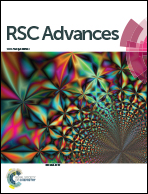Asymmetric passivation of edges: a route to make magnetic graphene nanoribbons†
Abstract
Zigzag graphene nanoribbons (ZGNRs) are known to carry interesting properties beyond graphene, such as finite and variable band gaps. More interestingly, the edges of ZGNRs are magnetic due to single occupation of carbon dangling bonds (DB). However, the magnetic moments at two different edge sides couple antiferromagnetically, leading to a zero global moment for ZGNRs. Furthermore, the application of ZGNRs is limited by the high chemical activity of their edges that can be easily oxidized while exposed in air. It has been proposed and intensively studied to protect the edges by passivating them by hydrogenation or adsorption of other molecules such as CO2. In this work, we systematically studied the stability, the structures and the effect of CO2 adsorption at the edges of ZGNRs. Our calculations confirm the experimental observation that the CO2 molecules can be easily absorbed by the ZGNR edges. More interestingly, our calculations show that the asymmetric CO2 adsorption at two edges of ZGNR yields a ferrimagnetic state of ZGNRs that presents a finite global moment. Furthermore, considering the strong bonding between CO2 groups and ZGNRs, we propose that it can be utilized to stitch arrays of ZGNRs together to form new types of 2D materials that inherit the advantageous properties of the nanoribbons, such as finite gaps and novel magnetic properties.



 Please wait while we load your content...
Please wait while we load your content...